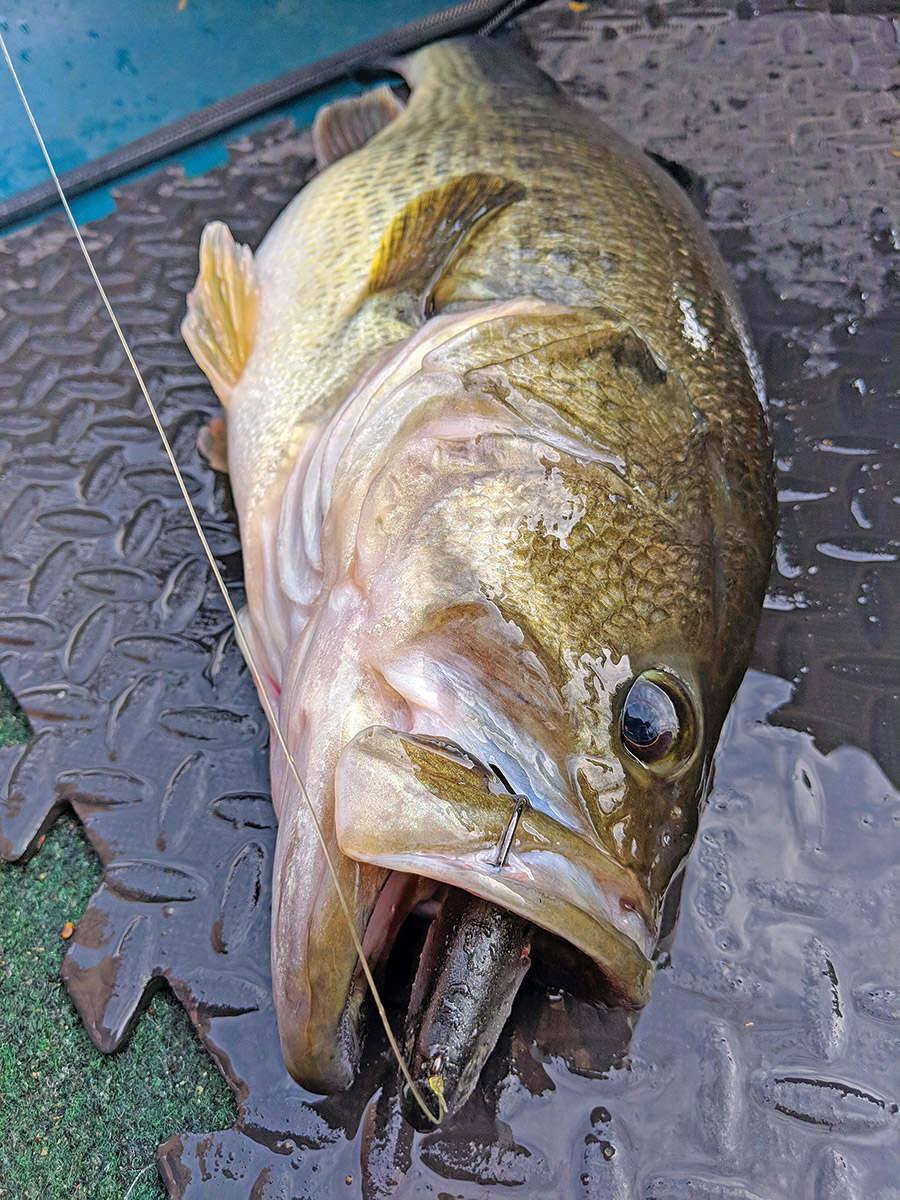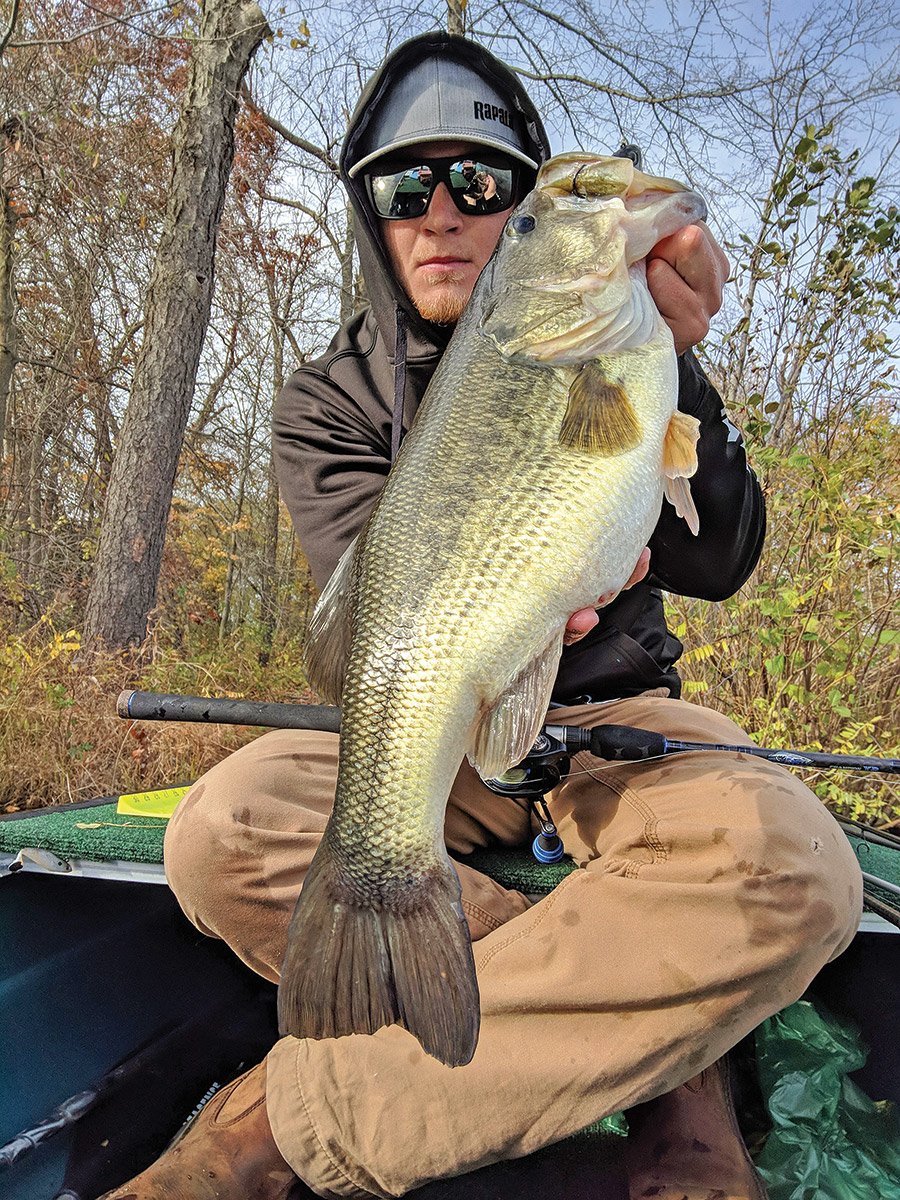
Successfully accounting for tight windows requires instinct and dedication.
Last August as I was scheduling classes for the upcoming semester, my goal was to coincide my break between classes with the best possible time to fine tune my skills with throwing large swimbaits for trophy sized largemouth bass.
Having the instinctive feeling of my local beaches not being able to produce enough action to motivate me to make that hour drive between classes, I wanted to focus on one of my other passions. I finalized my schedule and ended up having a small window from 11a.m. to 1 p.m. that I could use to take care of whatever business I needed to do, mostly involving a rod and reel.
At this point you are probably scratching your head asking, “Why would he pick the hottest part of the day to try and chase bass, especially one that’s above average?” Most fishermen have the presumption that freak sized largemouth only hit during the wee hours of the morning or as soon as the sun drops below the trees for the night. For me, those time periods are completely irrelevant.
As opposed to summer when their metabolism is ramped and feeding periods last much longer, sometimes all day, largemouth start to shorten their times of heavy feeding and begin eating midday with more and more frequency in the fall. With a multitude of factors playing into this behavior the most important one for me is light penetration, especially on bodies of water that are stained or have a bit of color to them. I use a large profile bait that displaces a large amount of water; I want as many bass as possible to get a look at my bait to up my odds of getting one to commit.
With swimbaits the most important sense is sight. During the months of October, November, and December the 11 a.m. to 2 p.m. stretch has some of the best light; even the deepest part of the lake will have a glowing sense of clarity to it.
Lunar Cycle Largemouth
Moon phase is closely observed more by saltwater anglers, yet freshwater guys for the most part could care less. Big mistake. It matters to me and is not a coincidence if you were to journey into my log books. For whatever reason, the biggest fish I encounter feed on both the full and new moon phases, as well as a day or two on either side. I have recorded over two dozen fish over 5 pounds caught during this very same pattern just this year alone, regardless of season or water temperature, while throwing big baits. Note that the beginning of a storm front accompanied by the lunar phase is even better.

So, as I was sitting in class, I decided to check what part of the moon phase we were in. Class seemed like it was taking forever, mostly since a blanket of anticipation fell over me; suddenly that feeling of hesitation turned into a quest to see if I could see if my timing was on the money or completely off. By 11:30 a.m. I was launching the boat, armed with two rods and a small bag of baits suited for the conditions at hand. Breaking down the lake for the day, I began by letting the wind blow me down the bank while I covered water at a good rate with a deep diving jerk bait in a ghost shad pattern, a standard for clear sunny days. It took me two passes down that side of the lake to coax a good-sized bass to take a shot. Even with three hooks on the bait, that fish still managed to spit it like nothing was there.
Visibility was decent and was just clear enough to make out the fish cutting left and right following the lure as it changed angles coming up towards the boat. Eventually that fish got so close it saw me and disappeared back into deeper water. To paint a picture, this fish was positioned on the downwind side of a small underwater point leading to sudden depth change. Steep banks give predators the comfort to run up shallow to feed, or the convenience to sit out deep and look up towards the shallows. This sudden depth change in such a small area will give the fish access to both shallow and deep water without having to exert more energy swimming a further distance to reach both.
Balance is the key, just like in our lives. Other than a steep bank, this side of the lake I was on is featureless so even the smallest form of bank extension could serve as much holding power as a larger point. Being crunched on time and not relying on electronics, I used my only visual clue of the day—that one lonely follow—to form an even more disciplined plan. After finding where that fish was holding, I decided it was the perfect opportunity to try and get a fish to commit to a larger bait. The jerk bait did a fine job at getting an inactive bass to lash out instinctively and show itself. Most would have passed right on by without paying that small 3-pounder any mind, but you have to observe and use every bit of information you can get.
Bank by Boat
Boat positioning is everything when swimbait fishing. Casting out into deeper water and then bringing my bait towards the shallows rather than casting up shallow and fishing towards deep water is how I planned my attack. I adapted this way of thinking from the overly successful swimbait fishermen on the West Coast. When dealing with a large meal, bass prefer to use this upward angle as a pinch point to reduce the chances of their prey escaping. Many other predators use these angles to their advantage, including striped bass in the surf environment as well as pelagics corralling bait in the open ocean. As an aside, I would attack this spot from the bank if there was better access to this part of the lake so the disturbance of my boat was not in the water. That alone should give bank anglers the confidence they need to pursue these giants as well.

So I made sure I was as close as I could get to the bank, throwing my anchor up into the bushes to hold me there. The bait I was using has a rate of fall of about 5 feet every 10 seconds and took about 30 seconds until I touched down on bottom. This is how I was able to know what depth I was fishing without using electronics. After touching bottom, I let it rest for a little before starting the painfully slow retrieve that is normally needed to fool these beasts. At this moment my heart was beating out of my chest expecting to feel that telltale thump of a good fish. To my surprise nobody was home. At least so I thought.
After about 20 minutes of repeating that pattern to no avail, I stopped fishing completely to not spook what might be there. I literally kicked my boots off and sat there for a minute observing and thinking what I could do differently since I knew at least one fish lived on this spot and was willing to chase. Out of the corner of my eye I saw a small school of gizzard shad rise to the top and quickly disappear. Then another single one rises not even 5 feet from the boat. This is a battle against time when throwing the big baits hoping that the bass and baitfish mess up and give away a clue before they realize what’s going on. It was enough for me to assume that the bass were not lethargic enough to be holding tight to the bottom. Follow the bait, right? Suspended bait, suspended bass, bingo!
Following this crucial observation, I picked up my rod and waited for a stronger gust of wind to carry my bait even further than the last cast. Instead of counting down to the bottom, I engaged the reel instantly and began slowly swimming the bait towards me at a snail’s pace but in the upper half of the water column. I didn’t get more than six handle turns into that cast when the hardest hit I ever felt knocked slack in my line signaling a fish ate the bait, pushing a wall of water forward as it turned its head. My 7-foot, 9-inch heavy action rod doubled over, and without pulling the bait out of the fish’s mouth, I leaned into it with all I had and began grinding this fish back to the boat, hoping I had her pinned in a good spot.
Keep in mind this was all going down without having my boots on, so I almost fall out of the boat trying to reach for this fish. When I finally got a grip on her, I knew it was a good fish. She had the length, the girth, and displayed quite the pulling power of a true Jersey giant. While holding the fish in the water with one had I slipped my boots back on with the other then made sure the padded floor mat of my boat was wet so when I briefly lifted her in no slime would be taken off.
All said and done I got measurements and took four good shots of her by leaning my phone up against my bag and using the three-second self-timer to allow me to back up and get the whole fish in the frame. With a length of 21-1/2 inches, she weighed a respectful 7.59 pounds. Not my largest but truly a remarkable catch considering the odds I beat, and for our region in general.
Watching them swim off is always second best to having that initial hit. Hopefully against other odds that fish will grow to be double digits in a short while. I did not make another cast for the rest of the outing, and it took about a half hour to load my boat back up and book it back to campus. With soaking wet socks, I sat in class reliving how the day played out repeatedly in my head. In the inspirational words of my grandfather; improvise, overcome and adapt.
I don’t share this experience for a claim to fame or to provide a list of my techniques to live and die by. But instead it’s perhaps to persuade other anglers to fine tune their instincts to really get in touch with the water. In this revolving world of social media, it is easy to duplicate someone else’s play-by-play success, but what works for me might not work for you.
Be innovative, observe, live on the water as much as possible and the rest will fall into place. Don’t rush perfection and best of luck.




